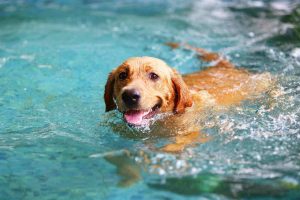Dry Drowning: What Is It And How Do I Prevent It For My Dog
 Everyone knows of drowning when a person or a pet is submerged in water and can’t get oxygen. Have you heard of dry drowning? Dry drowning occurs when water is aspirated into the lungs or other parts of the airway. If the water doesn’t make it to the lungs, the vocal cords can begin to spasm making breathing difficult. If water does make its way to the lungs, serious complications and even death may occur. The latter condition is referred to “secondary drowning”, but it’s usually also referred to as dry drowning. Dry drowning is a scary thing as it can ‘happen’ HOURS after exposure to water. It’s something that affects all animals with exposure to water, from humans to dogs.
Everyone knows of drowning when a person or a pet is submerged in water and can’t get oxygen. Have you heard of dry drowning? Dry drowning occurs when water is aspirated into the lungs or other parts of the airway. If the water doesn’t make it to the lungs, the vocal cords can begin to spasm making breathing difficult. If water does make its way to the lungs, serious complications and even death may occur. The latter condition is referred to “secondary drowning”, but it’s usually also referred to as dry drowning. Dry drowning is a scary thing as it can ‘happen’ HOURS after exposure to water. It’s something that affects all animals with exposure to water, from humans to dogs.
How does dry drowning happen? It can be brought on by a dramatic water event or just a typical bath. A dog whose head goes under the bathwater is just as susceptible as a dog who actively jumps into the pool. In a lot of cases, dry drowning doesn’t look like much at all as the condition starts to shape.
Dry drowning is caused by swallowing water. That’s it! For a moment, consider how large your dog’s mouth is and imagine what it feels like when you go underwater unprepared. The natural instinct is to gasp for air, and it is unavoidable. If your dog has the same instinct, your dog could swallow a lot of water in just one gulp.
If water has gotten into your dog’s lungs, it could take hours or in some cases even days for signs to show. The most common symptoms include coughing or hacking, signs of chest pain, difficulty breathing or wheezing, and extreme lethargy. If you suspect your dog may be suffering from dry drowning, take your dog to the vet immediately. Even if your dog doesn’t seem to be in duress, it’s best to have your dog checked out just to be sure.
It’s important to note that dry drowning can happen as a result of swallowing sand as well. A dog who respirates a lot of sand can suffer the same ill effects of secondary water drowning and should be checked out by a vet.
To protect your dog from dry drowning, be sure to monitory your dog closely around water. Even if your dog is a prolific swimmer, you want to keep an eye on your dog to make sure that a swallowing episode doesn’t occur. It only takes one swallow to dry drown. If your dog is around water frequently, invest in a fitted life jacket to ensure that your dog’s head stays above water as much as possible. HERE is an article from the American Kennel Club listing multiple safe options. Even though most dogs can doggie paddle, their arms get tired just like ours do. Lastly, always take “near” drowning seriously. Even though dogs have a natural swim instinct, if you ever have to “rescue” your dog from the water you should watch her closely for several days afterwards to look for signs of secondary drowning.
As always, if you have any questions or wish to make an appointment, contact Dr. Olsen at Olsen Veterinary Clinic or call us at 618-656-5868.
